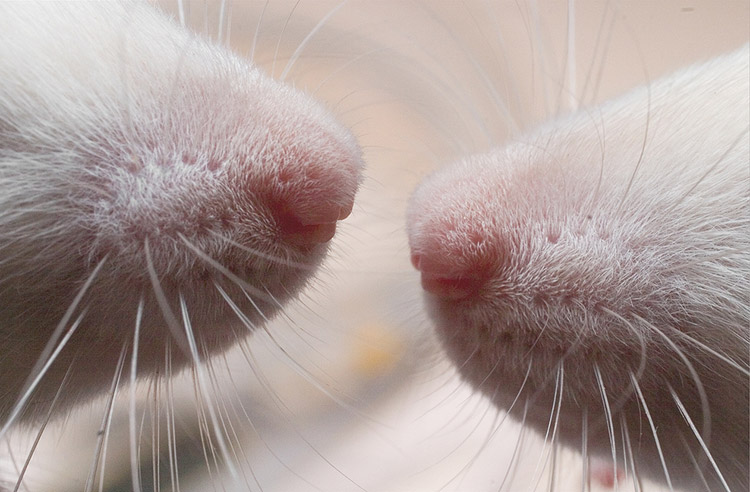Breathing is a Rhythm for Life, and More
Published Date
By:
- Susan Brown
Share This:
Article Content

Rodents explore their world with their snouts. Photo by Alexey Krasavin
Respiration is more than just an essential rhythm for life. A new study has found that rhythmic neural patterns that control breathing also coordinate movements of muscles on the mouth and face that serve a variety of sensory, ingestive and social behaviors.
We constantly coordinate competing motions. We walk while we talk and breathe, and can run while we catch, throw or strike objects. How our nervous systems comply with essential biomechanical constraints, such as swallowing without inhaling, and avoid competing movements that work against each other is a fundamental question for neurophysiology.
In a paper published in the April 1 issue of Neuron, the National Institute of Neurological Disorders and Stroke BRAIN project team of Martin Deschênes of Laval University in Quebec and David Kleinfeld of the University of California, San Diego, addressed the issue by studying the neuronal computations that lead to coordinated motions on the snouts of rodents.
Nocturnal rodents explore their worlds by sweeping their whiskers, a behavior called “whisking,” and sniffing. Both rhythmic behaviors, as well as breathing, are controlled by oscillators in the brainstem. In past work, Deschênes and Kleinfeld showed that the oscillator that controls inspiration also acts as like an orchestral conductor beating time to coordinate the clock for whisking.
Their new work determined key aspects of the underlying circuit that coordinates two separate actions in space and time.
A surprising aspect of the findings was that rhythmic inhibition, that is, the suppression of motor activity as a means to control motion, rather than turning the activity on, plays an extensive role in synchronizing rhythmic motions. They also found that circuits that control breathing are essential to coordinating other motor activity, such as whisking and sniffing, across the right and left sides of the body.
“By working backward from the behavior to the brainstem, we were able to decipher the circuitry,” said Duchênes, a professor of psychiatry and neuroscience at Laval University who has collaborated with Kleinfeld on the project for six years. “We tend to think of the brain as divided between circuits that keep us alive, that control our heartbeat and lungs, with the rest somewhat separate, for thinking and exploring the world. This shows that they are actually tightly entwined.”
The circuits that control these behaviors are all found in the brainstem a part of the brain with an architecture that is closely shared between rodents, humans and other mammals. The lessons learned from unpacking this brainstem circuitry likely apply broadly to how nervous systems coordinate competing movements.
“This is a wonderful example of curiosity driven research,” said Kleinfeld, Distinguished Professor of physics, neurobiology, and electrical and computer engineering at UC San Diego. “Martin and I have different backgrounds and strengths but together we were able to crack a hard nut of a problem.”
Co-authors include Jun Takatoh and Fan Wang of Duke University Medical Center, Anastasia Kurnikova and Jeffrey Moore of UC San Diego, Maxime Demers and Michael Elbaz of Laval University, and Takahiro Furuta of Kyoto University. The National Institute of Neurological Disorders and Stroke, National Science Foundation, National Institute of Mental Health, Canadian Institutes of Health Research, Japan Society for the Promotion of Science and U.S.-Israeli Binational Foundation supported this work.
Share This:
You May Also Like
UC San Diego is Strengthening U.S. Semiconductor Innovation and Workforce Development
Technology & EngineeringStay in the Know
Keep up with all the latest from UC San Diego. Subscribe to the newsletter today.



